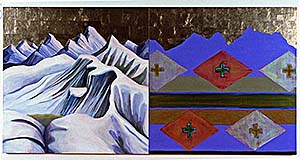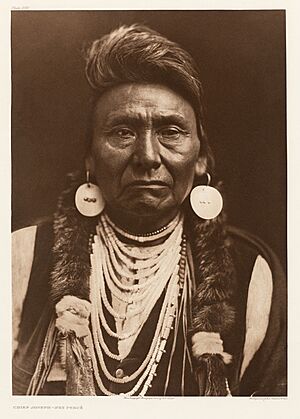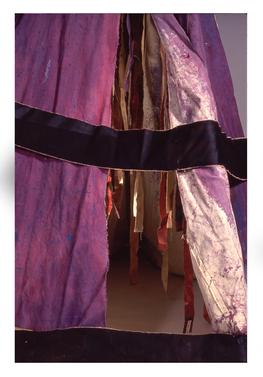Kay WalkingStick facts for kids
Quick facts for kids
Kay WalkingStick
|
|
|---|---|
| Born | March 2, 1935 Syracuse, New York, U.S.
|
| Nationality | American, Cherokee Nation |
| Education | Beaver College (BFA) Pratt Institute (MFA) |
| Known for | Painting, mixed media, drawing |
| Awards | National Endowment of the Arts; Joan Mitchell Foundation award; Women's Caucus for Art National Honor award for Achievement in the Arts Distinguished Artist Award from the Eiteljorg Museum of American Indians and Western Art; Lee Krasner award for lifetime achievement of the Pollock-Krasner Foundation |
Kay WalkingStick (born March 2, 1935) is a famous Native American artist. She is a member of the Cherokee Nation. She is well-known for her landscape paintings. These paintings are often made with oil paint on wood panels. She sometimes adds patterns from Southwest American Indian rugs and pottery to her art.
Kay WalkingStick's artworks are displayed in many important museums. These include the Metropolitan Museum of Art and the Smithsonian National Museum of the American Indian. She has also written books. She used to be a professor at Cornell University, where she taught painting and drawing. She has won many awards for her art. In 1995, her work was even included in a major art history textbook called History of Art. Ms. WalkingStick is an Honorary Vice President of the National Association of Women Artists, Inc..
Contents
About Kay WalkingStick's Life
Kay WalkingStick was born in Syracuse, New York, on March 2, 1935. Her mother, Emma, was of Scottish-Irish background. Her father, Ralph, was a member of the Cherokee Nation. He could write and speak the Cherokee language. Ralph was born in Tahlequah, Oklahoma, which is the capital of the Cherokee Nation.
Kay's parents had four other children. Her father worked as a geologist in oil fields. While her mother was expecting Kay, she moved to Syracuse, New York. Kay grew up in Syracuse. She did not experience much of her Cherokee culture directly. Her older brothers and sisters, who lived in Oklahoma for a time, knew more about their father's traditions. Kay's mother told her "Indian stories" and spoke proudly of their Native American heritage. Kay loved to color and draw from a very young age.
WalkingStick married R. Michael Echols in 1959. They had two children, Michael David and Erica. She later married artist Dirk Bach in November 2013. They live in Easton, Pennsylvania.
Kay WalkingStick's Education and Training
Kay WalkingStick earned her first art degree, a Bachelor of Fine Arts, in 1959. She studied at Beaver College in Glenside, Pennsylvania. Ten years later, she received a special fellowship for women. This allowed her to attend Pratt Institute in Brooklyn, New York. She completed her Master of Fine Arts degree there in 1975.
WalkingStick also spent time at several artist residency programs. These programs give artists a quiet place to focus on their work. She was at the MacDowell Colony in New Hampshire in 1970 and 1971. She also worked at the Yaddo Artists' Colony in Saratoga Springs, New York, in 1976. In 1992, she painted in Bellagio, Italy. In 2011, Arcadia University gave her an honorary degree.
Kay WalkingStick's Art Career
Becoming an Artist
After college, Kay WalkingStick created art that looked very realistic for about ten years. When she went to graduate school in the early 1970s, her art became more abstract. Her abstract works were shown in many New York City art shows. This was a time when Native American artists were not often featured in galleries.
In graduate school, she started to study Native American art and history. She wanted to understand her "Indianness" better. She began a series of artworks about Chief Joseph. He was a 19th-century leader of the Nez Perce people who resisted being forced onto reservations. WalkingStick used wax and acrylic paint on canvas for these pieces. She would leave parts unpainted and cut designs into the wax.
Later, she added other materials to her art. These included small rocks, pieces of pottery, and copper. She would apply paint with her hands or a knife to create her final artworks.
In 1974, WalkingStick created a work called Messages to Papa. This piece helped her explore her feelings about her father. It showed a tipi, which is a Native American dwelling. Even though it's not a Cherokee structure, she used it as a symbol for Native Americans. In the middle of the artwork, she included a Cherokee language translation of the Lord's Prayer and a letter to her father.

WalkingStick is now most famous for her use of diptychs. These are artworks made of two panels. She explained that diptychs are a powerful way to show how different things can come together. This idea is especially meaningful for people who have mixed backgrounds, like her.
She started making abstract and landscape diptychs in 1985. These works brought her national and international recognition. Often, one panel of her diptychs is abstract, and the other shows a realistic image. She has painted landscapes of the Rocky Mountains, the Alps, and ancient sites like Mesa Verde and Canyon De Chelly. She made sketches during her visits to these places.
WalkingStick says her paintings are not just landscapes. She sees them as showing two ways of looking at the Earth. One view is what you see, which changes quickly. The other is abstract and lasts forever. She tries to express what cannot be easily put into words and to connect the present with eternity.
In 1991, she created a landscape called Where Are the Generations?. This painting shows the rugged mountains and desert of the Southwestern United States at night. The empty spaces in the painting represent the impact that European colonists had on the Native American population. On the abstract side of the painting, words made of copper say: "In 1492 we were 20 million. Now we are 2 million. Where are the children? Where are the generations? Never born." Her name in the Cherokee language follows these words.
In 1995, her work was included in the art history textbook History of Art by H. W. Janson. This book is used in many universities. Her diptych Gioioso Variation I (2001) shows the Italian Alps. This painting was inspired by her many trips to Italy. It features beautiful mountain shapes and a dancing couple under a shiny, gold sky.
In 2004, she painted Wallowa Mountains Memory, Variations. This painting shows the Wallowa Mountains, which were once the homeland of the Nez Perce people. A gold leaf sky is used on both sides of the diptych. The right side shows purple mountains with a Nez Perce corn husk bag design. The left side has gray and white mountains. This painting is now in the Metropolitan Museum in New York City. Her later paintings often combine American landscapes with patterns from Native American baskets, weaving, or pottery. These patterns come from the people who live or lived in those same landscapes.
Kay WalkingStick as an Educator
In 1988, Kay WalkingStick became an assistant professor of art at Cornell University in Ithaca, New York. She taught there until 1990. Then she worked at the State University of New York, Stony Brook for two years. She returned to Cornell University in 1992 as a full professor. She taught drawing and painting until she retired in 2005. After retiring, she moved to New York City to focus on her art full-time. She is now a professor emerita from Cornell University.
Awards and Recognition
Kay WalkingStick has received many important awards for her contributions to art:
- 1983 - National Endowment of the Arts grant
- 1991 - Richard A. Florsheim Art Fund Award, which helped purchase her diptych "Letting Go From Chaos to Calm" for the Rockwell Museum of Western Art
- 1995 - Joan Mitchell Foundation award
- 1996 - National Honor award for Achievement in the Arts, from the Women's Caucus for Art
- 2003 - Distinguished Artist Award from the Eiteljorg Museum of American Indians and Western Art. She was the first woman to win this award.
- 2011 - Lee Krasner award for lifetime achievement, from the Pollock-Krasner Foundation
Kay WalkingStick's Artworks and Exhibitions
Key Artworks
- Message to Papa, 1974
- Chief Joseph series
- Paper Piece #1, 1975
- Abyss, 1989
- Where are the Generations?, 1991
- Gioioso Variation I, diptych, 2001
- Wallowa Mountains Memory, Variations, painting on wood, 2004
- Night Magic, 2001
- Winter Flight, 1998–1999
Art Exhibitions
Kay WalkingStick became a well-known artist in the 1980s and 1990s. Her works have been shown in many exhibitions in Europe and America. These include both solo shows (featuring only her art) and group shows (with other artists). Some places where her art has been exhibited include the National Museum of the American Indian, the National Gallery of Canada, and the Heard Museum.
In 2008, her exhibition "American Abstraction: Dialogue with the Cosmos" honored Native American women. It featured parfleche bags with landscape designs, like the Wallowa Mountains. These bags also had abstract designs from the Nez Perce and other Native American tribes. Parfleche bags were traditionally used to store and carry food and other items.
From 2015 to 2016, a major exhibition called "Kay WalkingStick: An American Artist" was held. It was shown at the National Museum of the American Indian in Washington, D.C., and the Heard Museum in Phoenix. This show was the first to cover her entire career, which spans over forty years. It included many works that show her unique cultural identity. Her art connects Native American history with other art movements like feminism and Minimalism. She is especially famous for her beautiful and powerful landscapes. These paintings fill natural scenes with personal and shared memories.
The Dayton Art Institute in Ohio also featured "Kay WalkingStick: An American Artist" from February to May 2017. The exhibition was also shown at the Montclair Art Museum in 2018.
In 2020, WalkingStick's art was part of the exhibition Hearts of Our People: Native Women Artists at the Smithsonian American Art Museum.
In 2023, the exhibition Kay WalkingStick/Hudson River School opened at the New-York Historical Society. This was her largest museum exhibition in New York City at that time.
Art Collections
Kay WalkingStick's artworks are part of the permanent collections in many museums and institutions:
- Albright-Knox Art Gallery, Buffalo, New York
- Bailey-Howe Library, University of Vermont
- Eli and Edythe Broad Art Museum, East Lansing, Michigan
- Cherokee Heritage Center, Park Hill, Oklahoma
- Cherokee Nation Foundation, Tahlequah, Cherokee Nation
- Dartmouth College, Hanover, New Hampshire
- Davidson College, North Carolina
- Denver Art Museum, Colorado
- Detroit Institute of Arts, Michigan
- Eiteljorg Museum of American Indians and Western Art, Indianapolis
- Gilcrease Museum, Tulsa, Oklahoma
- Heard Museum, Phoenix
- Herbert F. Johnson Museum of Art, Cornell, Ithaca
- Israel Museum, Jerusalem
- La Jolla Museum of Contemporary Art, California
- Metropolitan Museum of Art, New York
- Montclair Art Museum, New Jersey
- Muscarelle Museum of Art, Virginia
- National Gallery of Canada, Ottawa
- Smithsonian National Museum of the American Indian, Washington, D.C.
- Neuberger Museum of Art, Purchase, New York
- Newark Museum, New Jersey
- New Jersey State Museum
- Peabody Essex Museum, Salem, Massachusetts
- San Diego Museum of Art
- Southern Plains Indian Museum, Anadarko, Oklahoma
- Spencer Museum of Art, Lawrence, Kansas
- Steinman Hall and Shepard Hall, City University of New York
Publications by Kay WalkingStick
Kay WalkingStick has also written articles and essays about art:
- "Primal Visions: Albert Bierstadt 'Discovers' America," catalog essay, A Cherokee Artist Looks at the Landing of Columbus. Montclair Museum, New Jersey, 2001.
- "Democracy, Inc: Kay WalkingStick on Indian Law." Artforum 30, November 1991, pp. 20–21.
- "Native American Art in the Postmodern Era." Art Journal 51, Fall 1992, pp. 15–17.
- "So Fine! Masterworks of Fine Art from the Heard Museum," curator's essay, Great American Artists, Heard Museum, Phoenix, 2002.
- Foreword by Kay WalkingStick in "Modern Spirit, The Art of George Morrison" by W. Jackson Rushing III and Kristin Makholm. University of Oklahoma Press: Norman, 2013.
- "No Reservations," essay in "Changing Hands: Art Without Reservation 3," Museum of Art and Design 2012.



